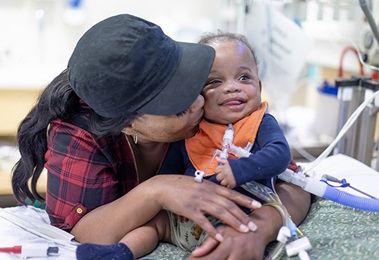Pectus Carinatum
What is pectus carinatum?
Pectus carinatum, commonly referred to as “pigeon chest,” is a chest wall malformation in which the sternum and ribs push in an outward direction. It occurs when cartilage, the bones of the sternum (breastbone) and ribs do not properly form and align.
Pectus carinatum occurs in approximately one in 1,500 children. It is more common in males than females.
Pectus carinatum can be present at birth, but it is often unnoticed until puberty, when it can develop and worsen during teenage growth spurts between ages 11 and 14.
Up to half of children with pectus carinatum will also have some component of pectus excavatum (a sunken chest). Sometimes, children experience pectus carinatum on one side of their chest and pectus excavatum on the other. It is important to note that the malformations may not be even, as one side may be more affected than the other.
Some children may be unhappy with the appearance of their chest, which can lead to lower self-confidence.
Pectus Carinatum Causes
The exact cause of pectus carinatum is unknown, but it can be associated with a variety of genetic disorders and syndromes, including:
- Marfan syndrome
- Noonan syndrome
- Cardiofaciocutaneous syndrome
- Poland syndrome
- Osteogenesis imperfecta
- Coffin-Lowry syndrome
- Morquio disease
In nearly 25% of pectus carinatum cases, there is a family history of chest wall issues.
Pectus Carinatum Symptoms
People with pectus carinatum have chest bones that stick out more than usual. Some patients may also experience pain in the chest, ribs and back.
A small percentage of those with pectus carinatum experience shortness of breath with exercise, which can occur with or without chest pain.
Pectus Carinatum Diagnosis
To diagnose pectus carinatum, the child’s doctor will do an external exam and ask about the child’s medical history. In addition, the doctor may request one or more diagnostic tests, which might include:
- Chest X-ray
- Computed tomography (CT scan)
- Magnetic resonance imaging (MRI scan)
Pectus Carinatum Treatment
Pectus carinatum is treated two ways. Initially, an external bracing device is used to treat the condition. If bracing fails, surgery is performed to correct the condition. The child’s doctor will suggest and review the process of the best correction method.
Chest Wall Brace for Pectus Carinatum
A chest wall brace is a lightweight device that is custom made for children or teens. Just like dental braces help realign teeth, a chest wall brace slowly pushes the breastbone back to where it would normally be. The device wraps around the chest and places mild pressure on the part that sticks out, and the breastbone should slowly shift into its proper place. Depending on the surgeon’s recommendation, the patient wears the brace for 12 or more hours each day for several months. Once the desired degree of correction has been achieved, patients only need to wear the brace at night in order to maintain the corrected shape.
External bracing is a cost-effective alternative to surgery, with good success rates, because the chest wall is able to be reshaped during the adolescent years. For bracing to work, it requires long-term patient compliance with the treatment plan.
Surgery for Pectus Carinatum
Surgery may be the best treatment option in cases of:
- Severe malformation
- Failed bracing
- Noncompliant chest
- A combined malformation of pectus carinatum and pectus excavatum
Ravitch Procedure
Surgical repair is performed with a horizontal incision across the middle of the child’s chest. During the procedure, the surgeon repairs and reshapes the ribs, breastbone and cartilage that make up the chest wall. A bar or bars may also be placed in the chest to ensure that the chest keeps its proper position. In most cases, the bars will stay in place for six to 24 months. A surgeon will then perform an operation to remove the bar.
The child’s care team may recommend physical therapy exercises after recovery from surgery to strengthen weakened muscles.






